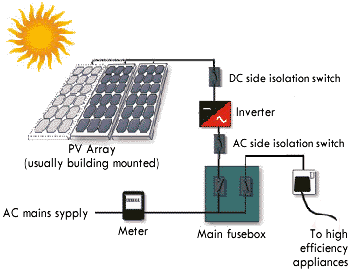 |
What
is Solar Photovoltaic (PV) technology?
Photovoltaic technology means converting solar light directly into electricity.
Thus, the most abundant free energy - that from the sun - can be harnessed
to power domestic electrical equipment such as kitchen appliances, computers,
and lighting. This is different from solar thermal technology used for hot
water.
The technology consists of PV cells connected together in PV modules (panels or arrays) which are semiconductors, typically made of crystalline silicon. When exposed to sunlight, the PV cells produce direct current (DC) electricity, which in order to use in the home is conducted to an inverter and transformed into AC electricity. The PV cells respond to both direct and diffuse solar radiation, meaning that even in overcast days a PV system can produce electricity. The output however is greater when there is more sunshine. The conversion efficiency range is between 5-15%.
| Are
PV systems suitable for domestic use? PV technology is ideally suited to use on residential buildings, providing pollution and noise-free electricity without using extra space. The use of photovoltaics in households has grown substantially in the UK over the last few years, with many impressive examples already in operation (see photo). PV systems can be incorporated into buildings in various ways. Sloping rooftops are an ideal site, where modules can simply be mounted using frames. Photovoltaic systems can also be incorporated into the actual building fabric, for example PV roof tiles are now available which can be fitted as would standard tiles. |
 |
Grid
connected PV systems
In urban areas domestic PV systems are normally connected to the grid in order
to maximise their utility. When the solar system is generating more electricity
than is being used, the excess automatically flows into the grid and is sold
to the power supply company servicing the household. When the power demand
is greater than what the system is generating, electricity is automatically
drawn from the grid. For specific guidance on grid connection look up the
Engineering Recommendation G77 (2000) published by the Electricity Association.
How does a typical system work?
|
1.
PV array Daylight reaches the PV array and is converted to electricity, even on cloudy days. There are no moving parts so this happens silently. 2. Inverter The electricity generated by the roof is DC (direct current). An inverter makes it AC (alternating current), in sync with mains electricity so that it can be used normally 3. Main fuse box The solar electricity is fed into the mains via your fuse box, for safety 4. Meter The PV array generates electricity during the day. Spare electricity automatically flows out to the grid and is sold back to your electricity supplier. Fitting an extra electricity meter will measure how much you export 5. Peak demand and at night Extra power is always available from the grid at times of high demand or when the PV system does not generate electricity (night time) |
Where
to put a PV system?
A house roof is ideal for installing a PV system - there is plenty of
‘unused’ space, the visual intrusion is minimal, and direct exposure
to sun light is the greatest. Roof conditions of course vary and several key
factors should be taken into consideration when assessing the solar potential
of your home:

